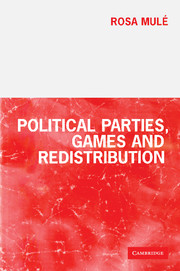Book contents
- Frontmatter
- Contents
- List of figures
- List of tables
- Acknowledgments
- Introduction
- 1 Political parties, games and income redistribution
- 2 Opposition effects, blackmail and u-turns under Pierre Elliot Trudeau
- 3 The arithmetics of politics under Margaret Thatcher
- 4 Right-wing ascendency, pivotal players and asymmetric power under Bob Hawke
- 5 The demise of the federal social safety net under Clinton
- 6 Conclusions
- Technical addendum
- Bibliography
- Index
4 - Right-wing ascendency, pivotal players and asymmetric power under Bob Hawke
Published online by Cambridge University Press: 22 September 2009
- Frontmatter
- Contents
- List of figures
- List of tables
- Acknowledgments
- Introduction
- 1 Political parties, games and income redistribution
- 2 Opposition effects, blackmail and u-turns under Pierre Elliot Trudeau
- 3 The arithmetics of politics under Margaret Thatcher
- 4 Right-wing ascendency, pivotal players and asymmetric power under Bob Hawke
- 5 The demise of the federal social safety net under Clinton
- 6 Conclusions
- Technical addendum
- Bibliography
- Index
Summary
POLITICAL BACKGROUND
In 1983 the Australian Labor Party (ALP) returned to office after a lengthy period in opposition. Under the leadership of Bob Hawke the party succeeded in winning four consecutive elections, breaking the historical pattern of short-term Labor governments followed by longterm Liberal–National Party coalition governments. During this period Labor set out to defy the stance which had been adopted under previous Labor governments by engaging in deregulation and in scaling down social security benefits. Similar pressures towards rolling back the state were encountered in other OECD countries, but enthusiasm for economic rationalism mostly came from the political right, from Reagan in the USA, Thatcher in Britain and Mulroney in Canada. What is surprising is that in Australia the manager of retrenchment was a Labor government.
When Labor took office in 1983 the economy had been struck by the most severe recession since the 1930s; inflationary pressures were mounting and unemployment was soaring. Adverse terms of trade meant that the budget deficit in 1983 reached almost AU$4.5 billion compared with an estimate of less than AU$1.7 billion.
A salient feature of Australia's vulnerability was the structure of her trade: a small economy dependent on a narrow range of exports (Easton and Gerristen, 1996). As the price of raw materials plummeted in the late 1970s, Australia registered large monthly current account deficits which precipitated the AU$ depreciation in February/March 1985.
- Type
- Chapter
- Information
- Political Parties, Games and Redistribution , pp. 116 - 157Publisher: Cambridge University PressPrint publication year: 2001



